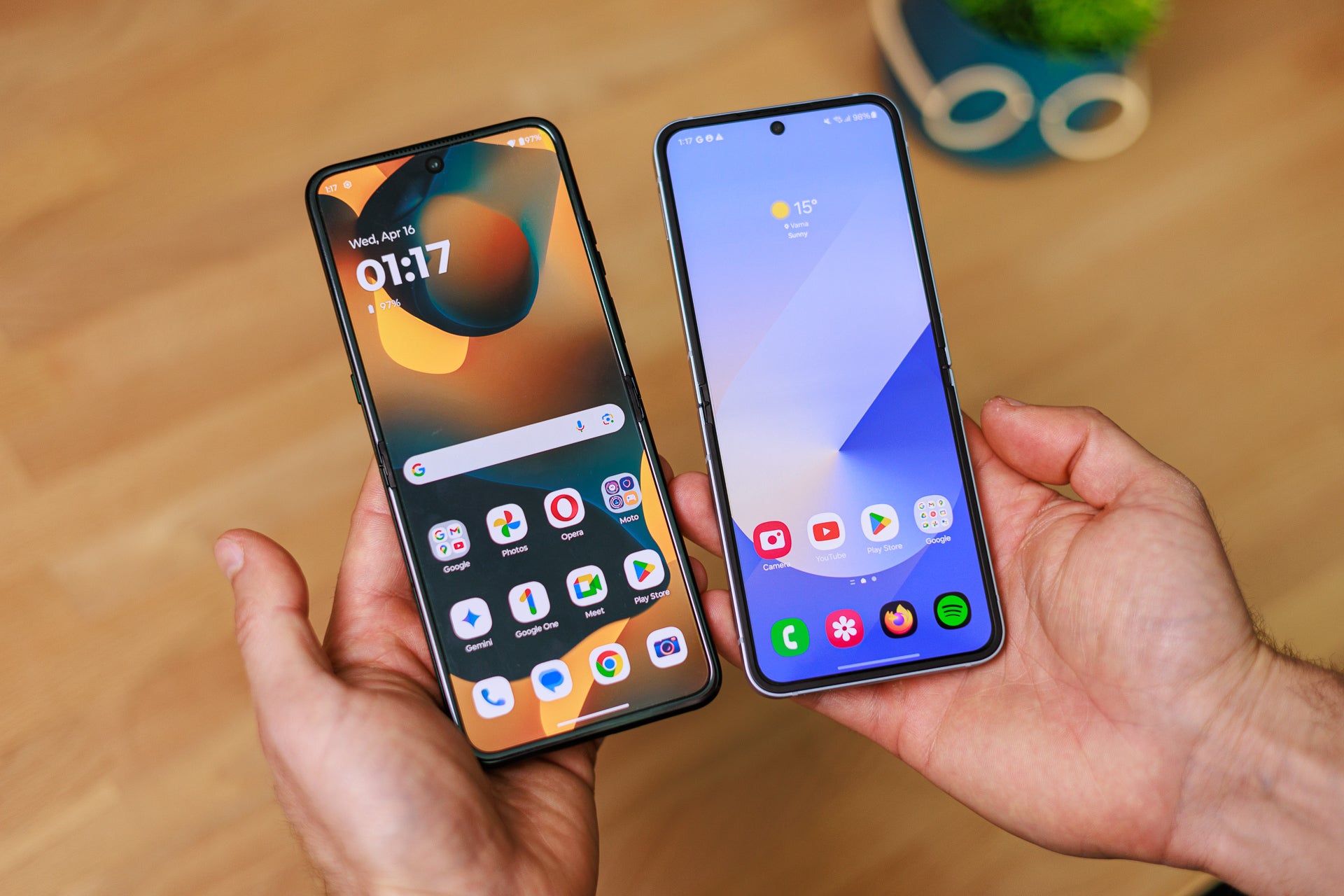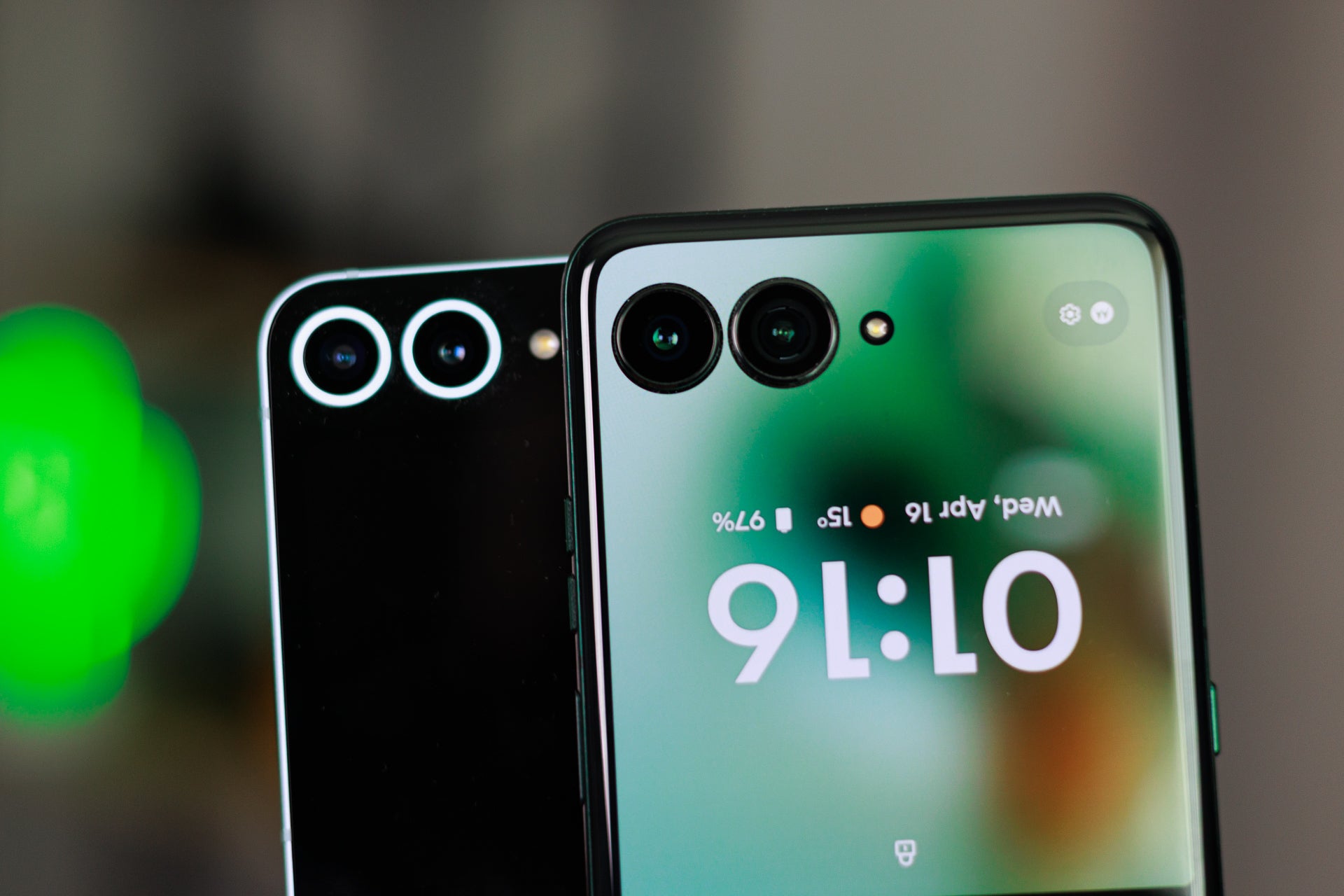Intro
It finally happened — Motorola brought the Razr series into the flagship category! This year, the company has introduced not two but three Razr models, and the new one is called Razr Ultra. It comes with a flagship processor, more RAM, and more storage!
Motorola Razr Ultra (2025) vs Galaxy Z Flip 6 differences explained:
| Motorola Razr Ultra (2025) | Galaxy Z Flip 6 |
|---|---|
| Larger but not much heavier | More compact |
| Larger 4-inch external display | 3.6-inch external display |
| 50 MP ultrawide | 12 MP ultrawide |
| Faster Snapdragon 8 Elite chip | Last-gen Snapdragon 8 Gen 3 |
| Leather and wood options | Only glass back panels |
| 4,700 mAh battery | A smaller 4,000 mAh battery |
| 68W wired charging | 25W wired charging |
| 30W wireless charging | 15W wireless charging |
| Starts at $1,300 with 512 GB storage | Starts at $1,100 with 256 GB storage |
| 16 GB RAM | 12 GB RAM |
Table of Contents:
Design and Display Quality
Motorola is different, Samsung plays it safe

The Razr Ultra comes in strong with its leather/velvet and wood back panels, both of which have much more character compared to the glass on the Galaxy Z Flip 6. | Image by PhoneArena
Flip phones are meant to be more compact and save you space in your bag or pocket, and both phones serve that function well. However, the Razr Ultra is larger than the Z Flip 6 no matter how you twist it, measuring 88.1 x 74 x 15.7 mm while folded vs the 85.1 x 71.9 x 14.9 mm of the Galaxy.
The size difference is noticeable, but only if you are using the two phones back to back, but both are plenty comfortable to use.
Without a doubt, though, the Motorola Razr Ultra stands out with its design. We have the Scarab Black version, which comes with a leather/velvet back that feels really soft to the touch. You can even get the new Razr with a wood back.
I am especially a fan of the leather back panel, not only because it is nice to the touch, but also because it does not attract fingerprints and does not slip as much from my pocket or when I place it on a surface.
The Z Flip doesn’t look bad, and it has the advantage of more color options, but it just doesn’t feel as special as the Razr.
The Razr Ultra colors are:
- Scarab Black (leather/velvet)
- Rio Red
- Mountain Trail (wood)
- Cabaret
- Silver Shadow
- Yellow
- Blue
- Mint
- Crafted Black (Samsung.com exclusive)
- White (Samsung.com exclusive)
- Peach (Samsung.com exclusive)

You get more screen real estate with the Razr. | Image by PhoneArena
With the larger body also comes a larger display, and in the Razr Ultra’s case, that’s true for both the main and the external one.
The main display measures 7 inches and it continues to have a 165Hz refresh rate. In comparison, the Z Flip 6‘s main display measures 6.7 inches and has a 120Hz refresh rate. The external display on the Razr is 4 inches vs the 3.4-inch one on the Galaxy.
While we can’t say that the difference in display refresh rates is noticeable, we can definitely say that the difference in display size is. The Razr Ultra is much more immersive and impressive when held next to the Z Flip 6, especially regarding the cover screen.
Display Measurements:
The Razr Ultra reached 2,424 nits brightness, while the Z Flip 6 topped out at 2,398 nits at 20% APL (Average Picture Level) during our display lab tests.
APL measures the average brightness of an image, expressed as a percentage of the maximum possible brightness. 100% APL would mean the image is completely white (at maximum brightness), while 0% APL would mean the image is completely black (at minimum brightness).
We measure brightness using a “20% APL” test by default. This means only 20% of the screen shows white while the rest stays black (with OLED, black means the pixels are off). We also test “100% APL,” where the whole screen is white, but that’s less accurate for OLEDs because manufacturers often limit brightness to protect the screen, and in real life, people rarely look at a fully white screen. That’s why the “20% APL” test better shows which phone has the brightest OLED display.
Performance and Software
How the tables have turned

The Razr Ultra comes with AI smarts and a faster processor. | Image by PhoneArena
The Razr Ultra packs the newer Snapdragon 8 Gen 3 Elite chip paired with 16 GB RAM, giving it a good performance boost, transforming it into full-fledged flagship phone ready to take on even the most demanding task you throw at it.
Games like Genshin Impact or apps like Adobe’s Lightroom work amazingly on the Razr Ultra.
The Z Flip 6 is with the older Snapdragon 8 Gen 3 chipset and 12 GB RAM, and it still performs perfectly fine by today’s standards, despite the benchmark results you will see below.
CPU Performance Benchmarks:
The CPU benchmark shows a 25% difference in performance when comparing these two phones.
The GPU performance is where we see a more stark difference between the two phones. More interesting here is the 3D Mark test (Low) test, which shows the dip in performance when the device gets overheated — also known as “throttling.”
Even under heavy GPU stress, the Razr handles heat better, allowing it to keep a higher performance even while throttling. This could be because of its larger body, which should be helping it dissipate heat more efficiently.
Storage-wise, the Razr starts at 512 GB. That’s more than the 256 GB on the base Z Flip 6, but you have to remember the $200 price difference too.
Camera
Similar in quality, but different in execution

Motorola opted for an ultrawide instead of a telephoto for the Razr Ultra’s secondary camera, matching the setup on the Z Flip 6. | Image by PhoneArena
On the Razr Ultra, you have a 50 MP x 50 MP x 50 MP combo for the main, ultrawide, and selfie cameras. The Galaxy Z Flip 6 also has a 50 MP main camera, but its ultrawide is 12 MP, and the front camera is 10 MP.
The Razr’s higher resolution ultrawide is not just for show, though, as you will see in the samples below.
PhoneArena Camera Score:
When it comes to photography, the Razr Ultra (2025) and Z Flip 6 are generally on par with each other, but where the Galaxy pulled ahead in our Camera Score was the video recording tests, primarily thanks to its main camera.
Main Camera
The Razr Ultra has clearly captured more detail in the shadow of the building, making for a more eye-pleasing image.
Zoom Quality
The Razr definitively wins when it comes to zoom quality. The image is visible sharper than that on the Galaxy Z Flip 6, and, in this case, the processing doesn’t look too much.
Ultra-wide Camera
The Galaxy shows more realistic colors and more balanced lighting, but the Razr’s ultrawide image is sharper.
Selfies
The colors from the Z Flip 6 look more natural, whereas the Razr Ultra’s image is somewhat warmer (yellowish). The selfie from the Galaxy also looks sharper in comparison, but the Motorola has done a better job at exposing the image, brightening up the darker areas.
More Camera Samples
Video Quality

The Razr’s video footage looks over-sharpened too contrasty, which gives it a weird look. The colors coming out from the Razr Ultra are also a bit off.
When faced with a high-contrast scene, it looks like the Razr favors exposing for the shadows, but blows out the highlights in the process, which means that they just appear as white (lacking detail). The Z Flip 6 does the opposite.
One thing’s for sure, though, the Razr’s ultrawide camera definitely captures more light, as you can see in the darker areas of the image where more detail is shown compared to the Galaxy. The Razr’s ultrawide is also sharper.
You can transition between the main and ultrawide cameras on both phones when shooting in 4K 30FPS, and it is smooth!
As for the zoom quality, neither has a dedicated telephoto camera, but both do a decent job considering that fact. That said, Galaxy can zoom in at 10x, whereas the Motorola maxes out a 6x.
Battery Life and Charging
Razr has longer battery life and much faster charging
PhoneArena Battery and Charging Test Results:
Interestingly, despite its massive lead in the Browsing test, the Razr Ultra was far behind the Z Flip 6 in our Video battery test. The two phones lasted almost equally during the Gaming test.
And despite its larger battery, the Razr charged almost 50 minutes faster than the Z Flip!
Audio Quality and Haptics
As for haptics, both phones offer good feedback for typing and notifications, but the Razr feels slightly sharper.
Specs Comparison
| Motorola Razr Ultra (2025) | Galaxy Z Flip 6 |
|---|---|
| Size and Weight 171.48 x 73.99 x 7.19 mm 199 g |
Size and Weight 165.1 x 71.9 x 6.9 mm 193 g |
| Main Display 7.0-inch LTPO AMOLED 165Hz |
Main Display 6.7-inch Dynamic LTPO AMOLED 2X 120Hz |
| External Display 4-inch LTPO AMOLED 165Hz |
External Display 3.4-inch Super AMOLED 60Hz |
| Processor Snapdragon 8 Elite (3nm) |
Processor Snapdragon 8 Gen 3 (4nm) |
| Versions 16/512GB for $1,300 |
Versions 12/256GB for $1099 |
| Cameras 50 MP main, f/1.8 50 MP ultra-wide, f/2.2 50 MP front. f/2.0 |
Cameras 50 MP main, f/1.8 12 MP ultra-wide, f/2.2 10 MP front, 2.2 |
| Battery 4,700 mAh |
Battery 4,000 mAh |
| Charging 68W wired 30W wireless 5W reverse wired |
Charging 25W wired 15W wireless 4.5 reverse wireless |
Which one should you buy?

Samsung has a tough competitor in 2025. | Image by PhoneArena
Motorola has truly outdone itself with the Razr Ultra. The company has slowly but surely been working towards this version of the Razr since the first one came out, and it now feels like we have reached the culmination.
Samsung’s Galaxy Z Flip 6 already felt a bit outdated because of its smaller external display when we compared it to last year’s Razr Plus, and it feels even more so when comparing it to the Razr Ultra.
“If you don’t want to wait for the Z Flip 7, the Razr Ultra is — dare we say — the perfect flip phone at the moment, and it’s definitely worth checking out.












